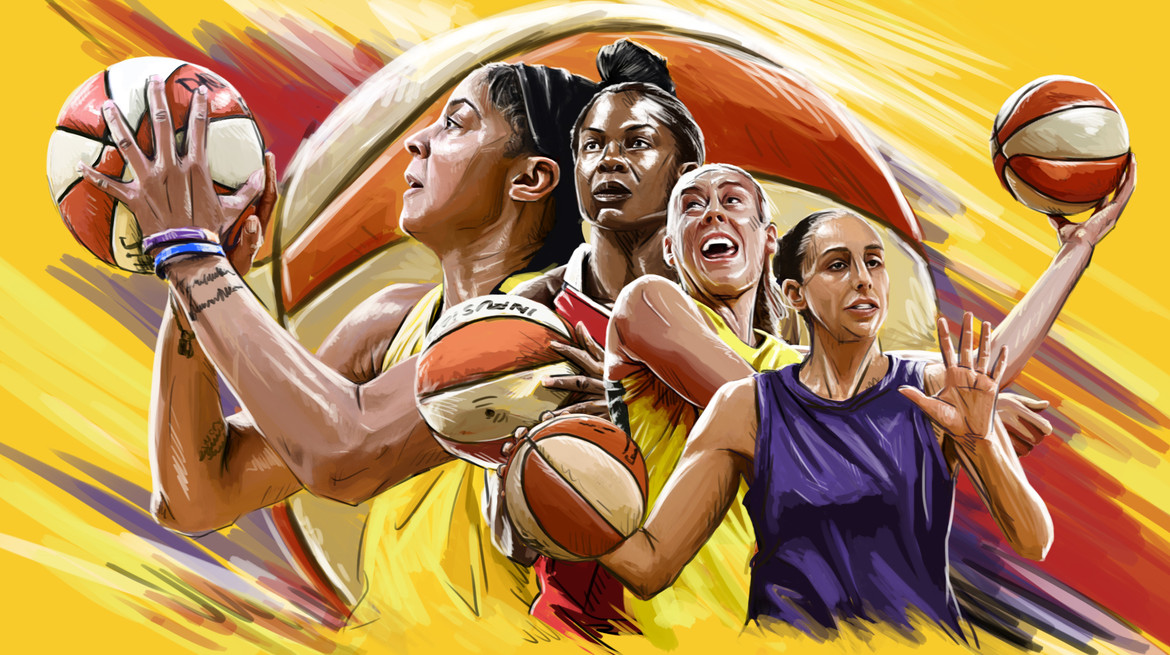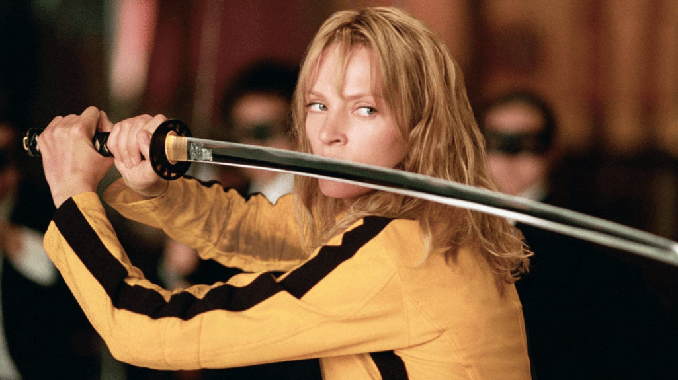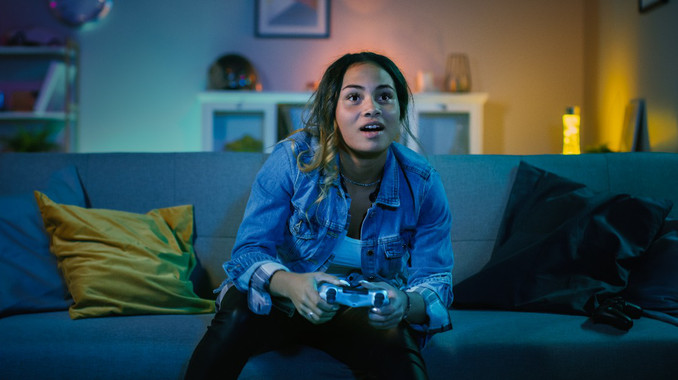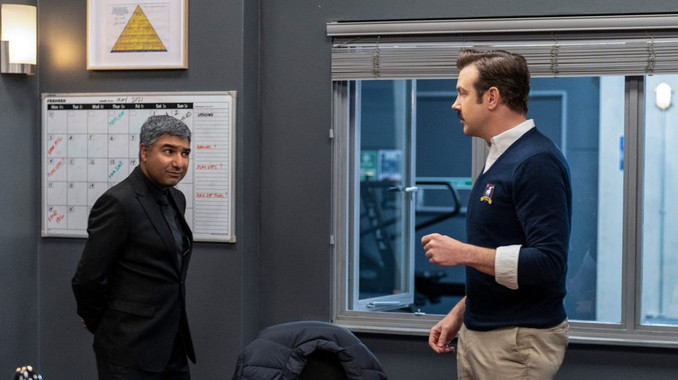The WNBA turns 23 this season, a number synonymous with basketball greatness. In the rich history of the WNBA, it’s hard to separate the greats from the GOATs, but a select group of players have launched the league from its beginnings into the elite circuit it is today.
Make that a few select groups. To best capture the league’s evolution, we’ve sorted its all-timers into four distinct, but overlapping generations. Season after season, the WNBA gets better and better. Here’s how it’s happened (and continues to happen), courtesy of the game’s best players.
The Originals: Dawn Staley, Rebecca Lobo, Cynthia Cooper, Lisa Leslie, Sheryl Swoopes
These five are the trail blazers who first took the court back in the mid-90s and showed the world just how entertaining a women’s basketball league could be.
Dawn Staley
No one better typified what a point guard looked like in the early days of the WNBA than Dawn Staley, a born leader who rose out of the Philly playgrounds to win three Olympic gold medals with USA Basketball, earn six trips to the WNBA All-Star Game, and lead her Charlotte Sting further, year after year, than anyone thought they’d go. Staley knew precisely when to make the pass and when to go to the hoop, a coach on the floor who has become a championship-winning coach on the bench for both South Carolina and USA Basketball.
Rebecca Lobo
Rebecca Lobo was there at the start of it all, the woman who literally tipped off the first WNBA game for the New York Liberty and became synonymous with the franchise. Even prior to that, she’d become basketball royalty after starring for Connecticut and turning her home state’s college team into a generationally dominant force. Now ESPN’s voice for women’s basketball year-round, few people evoke the first era of WNBA play like Rebecca Lobo.
Cynthia Cooper
After a stellar college career at USC, Cynthia Cooper dominated like few in the history of any sport. She won MVP honors in each of the first two WNBA seasons, along with four straight Finals MVP awards, as the leader of a Houston Comets squad that itself rose above the considerable competition to become the league’s elite team. Cooper was 34 when the league began play, leaving only one question about her career: what would it have looked like had the WNBA existed a decade earlier?
Lisa Leslie
Cooper’s fellow USC star Lisa Leslie helped define the center position right away with the Los Angeles Sparks, winning two WNBA titles and reaching eight All-Star games with an unstoppable array of post moves and a shot that extended beyond the three-point line. But she might be best known for her shortest field goal attempt, becoming the first player to dunk in a WNBA game back in 2002. Leslie’s dominance made her a popular choice as best player in team history, until Candace Parker came along and made it a debate.
Sheryl Swoopes
A do-it-all player for 15 seasons, Sheryl Swoopes followed up two incredible college years at Texas Tech with a WNBA run that defined success. Focus on her scoring and you’d miss her defensive mastery. Her eye-popping skills led Nike to launch the “Air Swoopes”, the first Nike signature shoe for a woman in the company’s history. But while her game was flashy, it stood the test of time – Swoopes was still hitting game-winners at age 40.
The Second Wave: Lauren Jackson, Tamika Catchings, Sue Bird, Diana Taurasi, Lindsay Whalen, Seimone Augustus
Though they stood on the shoulders of giants, these six WNBA stars reached – and continue to reach – new levels of play, solidifying the fandom of the first generation to tune into the league.
Lauren Jackson
If Rebecca Lobo and Lisa Leslie were the archetypal WNBA bigs, Lauren Jackson redefined the position, leading an offense like no one before her. The Australian product led the Seattle Storm to a pair of WNBA titles behind an offensive game that started at the midcourt line and ended with disaster for anyone guarding her at the rim. Jackson became impossible to stop anywhere on the floor, blocked shots at the other end, and accrued the second-most win shares in league history.
Tamika Catchings
The former Tennessee standout probably should have won MVP honors in her rookie year, when she was voted Rookie of the Year and immediately dominated at both ends of the floor. Catchings retained that level of play right through her 2016 season, which concluded with an Indiana Fever playoff appearance, an Olympic gold medal, and a career win share total that’s 20 percent better than anyone in the history of the WNBA.
Sue Bird
After a legendary career at UConn, where she won two national titles, Sue Bird got to the WNBA…and somehow got better. She’s come to define the point guard position as it exists today, consistently improving her team’s offense whenever she’s on the floor, setting the WNBA record for assists, sinking threes at an exceptional clip, and earning enduring love and respect from teammates and opponents. Oh, and she’s won three WNBA championships and four Olympic gold medals (so far).
Diana Taurasi
Quite simply, Diana Taurasi is the best big-game player in WNBA history. She won three straight NCAA titles at (surprise) UConn, and she’s equaled that number in the WNBA with the Phoenix Mercury. Her teams vary in makeup – fellow standout guard Cappie Pondexter her running mate early on, 6’9” big Brittney Griner her partner in basketball now. But the one constant is Taurasi’s fearless embrace of any chance the opposing defenders allow her, which is any time she finds even an inch of daylight to get her lightning-quick shot off.
Lindsay Whalen
When she got to Minnesota, the Lynx just started winning championships. After Whalen spent six years as the main attraction for an excellent Connecticut Sun team, newly-hired Lynx head coach Cheryl Reeve made bringing home the former University of Minnesota star her top priority. With Whalen running the show, the team took home the trophy in 2011, 2013, 2015 and 2017. For the entirety of the decade, Whalen seemed to find a way to make whatever play was required to lead Minnesota to victory, which happened most of the time.
Seimone Augustus
Whalen’s teammate played a prominent role in those wins, too, earning four WNBA titles after spending her first few years in Minnesota feasting on opposing defenders as perhaps the foremost iso player of all time (apologies to Cappie Pondexter). Augustus defined the midrange jumpshot, too, transforming what many viewed as a relic into a potent weapon for championship teams. Augustus is as tough as they come on both ends, and a public consciousness that began with Augustus on the cover of Sports Illustrated for Women while still in high school continues today.
The Stars of Today: Elena Delle Donne, Liz Cambage, Maya Moore, Candace Parker, Brittney Griner, Sylvia Fowles, Tina Charles
This elite, unstoppable group has lifted the league to another level. If there’s a trophy being awarded, it’s likely one of these seven is on the receiving end.
Elena Delle Donne
The University of Delaware product – who, by the way, quit basketball for a year to play volleyball as a walk-on for her home college team – took the Lauren Jackson idea to its logical extreme. A 6’5” unstoppable force driving through the lane, Delle Donne is likewise at ease handling the ball or pulling up for three. After being drafted by Chicago, she turned the Sky into instant contenders, then did the same in Washington after asking for a trade to be closer to home with the Mystics. Now she’s the single best one-on-one player in the game, the finest free throw shooter in league history, and a shot-blocker at the other end of the floor. In short, Elena Delle Donne is the most complete player the league has ever seen.
Liz Cambage
As unprecedented as she is peerless, Liz Cambage is doing things we simply haven’t seen before. Standing 6’8”, with muscles on muscles, opposing bigs bounce right off her 225-pound frame, fruitless in their attempts to move her or slow her down. Cambage can shoot it from everywhere, with a keen eye for finding her teammates, but she is at her unstoppable best employing an array of post moves in the paint. She’s the key to Las Vegas’ title hopes, which are made realistic because of her.
Maya Moore
She may be taking the 2019 season off, but Maya Moore still earns a place on this list. After what’s probably the greatest individual UConn career of all time, Moore came to Minnesota in 2011 to team with Whalen and Augustus, and the titles started flowing through the Twin Cities like the Mississippi. Moore simply wins everywhere she goes, and while her game itself contains plenty of pyrotechnics – an enviable midrange game, range beyond the three-point line, on-ball defending like no one else – Moore’s signature ability is making those few plays that turn a tight fourth quarter into a Lynx win. Hurry back, Maya.
Candace Parker
She finally broke through with a championship in 2016, but Candace Parker has been a force in the WNBA for a decade prior to that. Following an amazing collegiate career at Tennessee, Parker won both the Rookie of the Year and MVP Award during her league debut. Since then, she’s been and done everything for the Los Angeles Sparks, becoming the first player to average ten rebounds and six assists per game one year, leading the league in blocks another. A 6’4” point center with an unrivaled basketball IQ, she shows no signs of slowing down at 33.
Brittney Griner
Brittney Griner blocks shots. Sure, this might understate everything else that she does, from a wonderfully diverse post game, an impressive ability to pass out of frequent double-teams, an unstoppable midrange game (who cares if someone’s running at you when you’re 6’9”), and the ability to neutralize opposing centers. But still, those blocks. And not just the ones that end up in the box score. It’s the intimidation factor: the near-blocks, the hesitation instilled in driving opponents, the hundreds of shots altered ever so slightly to avoid Griner’s outstretched hand.
Sylvia Fowles
By the second year of her WNBA career in Chicago after a standout four seasons at LSU, Sylvia Fowles was everything you could ask from a center: an elite defender, a 60% shooter from the field, efficient and ruthless in equal doses. Fast forward a decade, and her intervening seasons have been largely interchangeable, save a trade from the Sky to the Lynx in 2015, whereupon she went from star to title-winning star, capturing WNBA Finals MVP honors in 2015. Whalen is retired, Augustus is injured, and Moore is missing this season of her own accord. But Fowles presses on, maintaining the Lynx’s championship pedigree as the best pure center in league history.
Tina Charles
This Queens-born UConn star has made herself into the force defining New York Liberty basketball for this generation as surely as Rebecca Lobo did the last one. An elite finisher at the rim and relentless rebounder, Charles worked to expand her game beyond the three-point line even after she’d won an MVP back in 2012 with the Connecticut Sun. A trade brought her home to New York in 2014, and she’s led the Liberty to playoff campaigns most seasons since, while showing up as the primary problem for every single New York opponent on every scouting report.
The Future Five: Breanna Stewart, Kelsey Plum, Jonquel Jones, A’ja Wilson, Arike Ogunbowale
After just a few seasons, these players have elbowed their way into the conversation. The future is now.
Breanna Stewart
This early into her career, Breanna Stewart is the future, yes, but she’s already been the present and really, much of the recent past. She came to (where else) UConn, declared she’d win four national titles in four years, and then did just that, earning Most Outstanding Player at the Final Four each season. Drafted by Seattle, she earned Rookie of the Year honors in 2016 on the strength of her effortless shot blocking, knock-down shooting, and lane-jumping transition D. With a 6’4” frame and 7’1” (!) wingspan, she’s less a force of nature like Delle Donne and more a flying trapeze artist. An Achilles injury cost her the 2019 season, but she’s still only 25. This 2018 WNBA MVP and title-winning star is just getting started.
Kelsey Plum
Kelsey Plum completed her University of Washington career as the NCAA’s all-time leading scorer and the top overall pick in the 2017 WNBA Draft, but she’s managed to take her complete game to another level in the Las Vegas backcourt. After a difficult start to her pro career with the San Antonio Stars, overcoming injuries and a conflict with her head coach, Plum is thriving with Bill Laimbeer, hitting threes at an elite rate, and serving as a floor general for a team with an overwhelming offense and championship aspirations. Her basketball IQ is enough to will those dreams to reality.
Jonquel Jones
Jonquel Jones wasn’t supposed to be this good. She lasted until the sixth pick in the 2016 WNBA Draft, where the Connecticut Sun happily scooped her up, and she’s been a next-generation force ever since. A 6’6” rebounding machine who sinks a high volume of threes at a 40%-plus clip, Jones has been elite on a per-minute basis since her rookie season. She won Sixth Woman of the Year honors in 2018, and dunked in the 2017 All-Star Game. But in 2019, she looks like an MVP for a team leading the WNBA standings, and at just 25, her ceiling is unlimited.
A’ja Wilson
Wilson did for South Carolina basketball and coach Dawn Staley what Lobo did for Connecticut basketball and coach Geno Auriemma. (Take Auriemma’s word for it.) A 6’5” forward with a guard’s sense of the court and a center’s ability to finish at the rim, Wilson picked up right where she left off in college after arriving in Las Vegas as the top overall pick in the 2018 WNBA Draft. She took home Rookie of the Year honors, and took the Aces to within an eyelash of the WNBA playoffs. Now teamed with Cambage, Plum, Kayla McBride and 2019’s top pick Jackie Young, Wilson looks poised to become as transformational in the WNBA as she was in college.
Arike Ogunbowale
This Notre Dame alum arrived in the WNBA already owning the kind of signature moments that will leave her a legend of the game. First, a buzzer beater to oust Connecticut from the NCAA Final Four. Two days later? The same thing, to beat Mississippi State and give Ogunbowale’s Notre Dame team a national title. Now in Dallas, playing for always-successful coach Brian Agler, Ogunbowale and the Wings are building together after dealing Cambage to Las Vegas this offseason. Ogunbowale is just 5’8, but she’s absurdly strong, and her ability to get to the basket, or create enough space to get off her midrange jumper, has been undeterred by bigger, stronger players. She’s already leading the Wings to surprising victories in this, her rookie season, and at 22, it will be fascinating to see what highlight films she lands on next.
![]()
The content is featured on https://www.directv.com/insider/ is editorial content brought to you by DIRECTV. While some of the programming discussed may now or in the future be available affiliates distribution services, the companies and persons discussed and depicted, and the authors and publishers of licensed content, are not necessarily associated with and do not necessarily endorse DIRECTV. When you click on ads on this site you may be taken to DIRECTV marketing pages that display advertising content. Content sponsored or co-created by programmers is identified as "Sponsored Content" or "Promoted Content."






